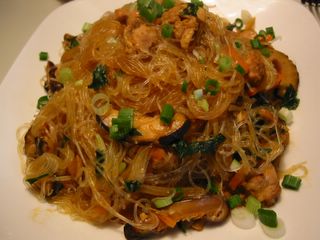Okay just to be sure here's another picture of the dish to highlight its orange hue. ;) Why do I sound so insecure?
I've always enjoyed the monthly IMBB food blogging event. It always gets me on my toes and have me scouring the deep recesses of my brain (and my stomach) of what to cook up. Like this edition, which incidentally is currently hosted by Foodgoat, demands food of the orange hue. It got me thinking a whole host of food ranging from Ginisang Carrot to Ginisang Kalabasa (squash). Hehehe. Is that all I can think of - ginisa (sauteed)?? Seriously, I was planning on making orange-glazed sweet potato (kamote!) or pancit palabok. But decided on doing this since it's not often that my family have this for lunch.
Sotanghon is the Filipino name for glass noodle (also bean thread noodles). While 'gisado' mean sauteed. Some people call this dish just Sotanghon but then they also call another soupy dish with this type of noodles of the same name. So I decided to append the 'Gisado' to indicate that it's cooked similar to that popular Pancit Bihon Gisado. Of paramount importance here is the quality of your chicken stock because the noodles will absorb it all and will therefore reflect its quality. If you can't or don't have time to make your own stock, local supermarkets usually have fresh meat or vegetable stocks in the chilled shelves. Otherwise, I recommend the Kallo brand of stock cubes - they do both organic and non-organic varieties.
Sotanghon Gisado
500 g boneless chicken meat - sliced into 1/2-inch pieces
200 g sotanghon (beanthread or glass noodles)
2 Tbsp oil
1 Tbsp minced garlic
1 medium onion - sliced
1 Tbsp patis (fish sauce)
2 1/2 cups chicken stock + 1/4 cup extra
4 dried shiitake mushrooms (or woodears/black fungus)
1/2 cup julienned carrots
1/4 cup chopped Chinese parsley or kinchay (or flatleaf parsley)
1 Tbsp annatto seeds or 1/2 tsp annatto powder (also called achuete or achiote)
1/3 cup hot water
2 green onions - chopped
salt and pepper to taste
- Soak sotanghon in water until soft (about 20 minutes). Drain and cut into desired lengths.
- Mix annatto seeds with the 1/3 cup hot water. Let stand for about 20 minutes. Mix and mash with fingers to extract red dye from the annatto and mix in with the water. Strain and discard annatto seeds. (If using annatto powder, just mix it with the water.)
- Pour enough hot water on the dried shiitake mushrooms enough to cover it. Soak for 20 minutes or until soft. Drain and squeeze excess water from mushrooms. Cut off stems and discard. Slice mushrooms thinly.
- Heat oil in a wok. Saute garlic and onion.
- Add chicken meat and patis; saute for awhile.
- Add 1/4 cup chicken stock and simmer in medium heat until chicken is just cooked (about 10-15 minutes). Let it dry out a little.
- Add chicken stock and annatto water; bring to boil. Stir in carrots, mushrooms and parsley. Simmer for 3-4 minutes.
- Add in sotanghon noodles, mix well and cook for another 2-3 minutes or until noodles is soft and cooked through. Put in salt and pepper according to your taste. Garnish with chopped green onions. Dish up and serve. (There will be some sauce left at this end stage. Don't worry, it will all be absorbed by the noodles as it cools down.)


No comments:
Post a Comment